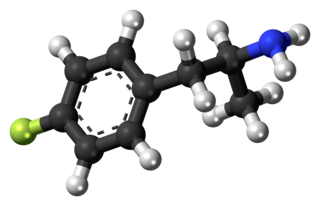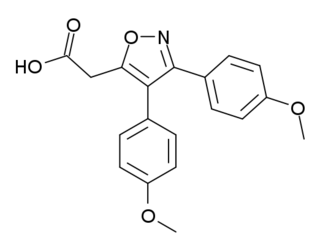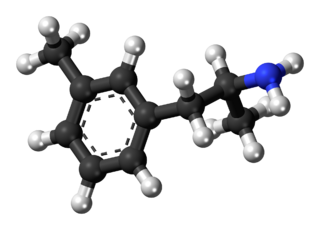
Non-steroidal anti-inflammatory drugs (NSAID) are members of a therapeutic drug class which reduces pain, decreases inflammation, decreases fever, and prevents blood clots. Side effects depend on the specific drug, its dose and duration of use, but largely include an increased risk of gastrointestinal ulcers and bleeds, heart attack, and kidney disease.
An antipyretic is a substance that reduces fever. Antipyretics cause the hypothalamus to override a prostaglandin-induced increase in temperature. The body then works to lower the temperature, which results in a reduction in fever.

Diclofenac, sold under the brand name Voltaren, among others, is a nonsteroidal anti-inflammatory drug (NSAID) used to treat pain and inflammatory diseases such as gout. It is taken by mouth or rectally in a suppository, used by injection, or applied to the skin. Improvements in pain last for as much as eight hours. It is also available in combination with misoprostol in an effort to decrease stomach problems.

3,4-Methylenedioxyamphetamine is an empathogen-entactogen, psychostimulant, and psychedelic drug of the amphetamine family that is encountered mainly as a recreational drug. In its pharmacology, MDA is a serotonin–norepinephrine–dopamine releasing agent (SNDRA). In most countries, the drug is a controlled substance and its possession and sale are illegal.

Ketorolac, sold under the brand names Toradol, and Biorolac among others, is a nonsteroidal anti-inflammatory drug (NSAID) used to treat pain. Specifically it is recommended for moderate to severe pain. Recommended duration of treatment is less than six days, and in Switzerland not more than two days. It is used by mouth, by nose, by injection into a vein or muscle, and as eye drops. Effects begin within an hour and last for up to eight hours.

4-Fluoroamphetamine, also known as para-fluoroamphetamine (PFA) is a psychoactive research chemical of the phenethylamine and substituted amphetamine chemical classes. It produces stimulant and entactogenic effects. As a recreational drug, 4-FA is sometimes sold along with related compounds such as 2-fluoroamphetamine and 4-fluoromethamphetamine.
Ganesha (2,5-dimethoxy-3,4-dimethylamphetamine) is a lesser-known psychedelic drug. It is also a substituted amphetamine. It was first synthesized by Alexander Shulgin. In his book PiHKAL, the dosage range is listed as 24–32 mg. The drug is usually taken orally, although other routes such as rectally may also be used. Ganesha is synthesized from 2,5-dimethoxy-3,4-dimethylbenzaldehyde. Ganesha is the amphetamine analog of 2C-G. It is a particularly long lasting drug, with the duration listed in PiHKAL as being 18–24 hours, which might make it undesirable to some users. It is named after the Hindu deity, Ganesha. Very little is known about the dangers or toxicity of ganesha. Effects of ganesha include:

para-Methoxyethylamphetamine (PMEA), is a stimulant drug related to PMA. PMEA reputedly produces similar effects to PMA, but is considerably less potent and seems to have slightly less tendency to produce severe hyperthermia, at least at low doses. At higher doses however the side effects and danger of death approach those of PMA itself, and PMEA should still be considered a potentially dangerous drug. Investigation of a drug-related death in Japan in 2005 showed PMEA to be present in the body and was thought to be responsible for the death.

3,4-Methylenedioxy-N,N-dimethylamphetamine (MDDM) is a lesser-known research chemical. It is also the N,N-dimethyl analog of 3,4-methylenedioxyamphetamine (MDA). MDDM was first synthesized by Alexander Shulgin. In his book PiHKAL , the dosage is unspecified and the duration unknown. MDDM produces only mild effects that are not well characterized in PiHKAL. Very little data exists about the pharmacological properties, metabolism, and toxicity of MDDM. This compound is however occasionally encountered as an impurity in 3,4-methylenedioxy-N-methylamphetamine (MDMA) which has been synthesized by methylation of MDA using methylating reagents such as methyl iodide. An excess of reagent or a reaction temperature that is too high results in some double methylation of the amine nitrogen, yielding MDDM as well as MDMA. The presence of MDDM as an impurity can thus reveal which synthetic route was used to manufacture seized samples of MDMA.
Benoxaprofen, also known as Benoxaphen, is a chemical compound with the formula C16H12ClNO3. It is a non-steroidal anti-inflammatory drug (NSAID) of the propionic acid class, and was marketed under the brand name Opren in the United Kingdom and Europe by Eli Lilly and Company (commonly referred to as Lilly), and as Oraflex in the United States of America (USA). Lilly suspended sales of Oraflex in 1982 after reports from the British government and the United States Food and Drug Administration (US FDA) of adverse effects and deaths linked to the drug.

Tenoxicam, sold under the brand name Mobiflex among others, is a nonsteroidal anti-inflammatory drug (NSAID). It is used to relieve inflammation, swelling, stiffness, and pain associated with rheumatoid arthritis, osteoarthritis, ankylosing spondylitis, tendinitis, bursitis, and periarthritis of the shoulders or hips.

Dimethylamphetamine (Metrotonin), also known as dimetamfetamine (INN), dimephenopan and N,N-dimethylamphetamine, is a stimulant drug of the phenethylamine and amphetamine chemical classes. Dimethylamphetamine has weaker stimulant effects than amphetamine or methamphetamine and is considerably less addictive and less neurotoxic compared to methamphetamine. However, it still retains some mild stimulant effects and abuse potential, and is a Schedule I controlled drug.

Pravadoline (WIN 48,098) is an anti-inflammatory and analgesic drug with an IC50 of 4.9 μM and a Ki of 2511 nM at CB1, related in structure to nonsteroidal anti-inflammatory drugs (NSAIDs) such as indometacin. It was developed in the 1980s as a new antiinflammatory and prostaglandin synthesis inhibitor, acting through inhibition of the enzyme cyclooxygenase (COX).

Mofezolac (INN), sold under the name Disopain in Japan, is a nonsteroidal anti-inflammatory drug (NSAID) used for its analgesic and anti-inflammatory actions. It is often prescribed for rheumatoid arthritis, lower back pain, frozen shoulder, and pain management after surgery or trauma. It is also being investigated for potential use in the treatment of neuroinflammation.
Cyclooxygenases are enzymes that take part in a complex biosynthetic cascade that results in the conversion of polyunsaturated fatty acids to prostaglandins and thromboxane(s). Their main role is to catalyze the transformation of arachidonic acid into the intermediate prostaglandin H2, which is the precursor of a variety of prostanoids with diverse and potent biological actions. Cyclooxygenases have two main isoforms that are called COX-1 and COX-2. COX-1 is responsible for the synthesis of prostaglandin and thromboxane in many types of cells, including the gastro-intestinal tract and blood platelets. COX-2 plays a major role in prostaglandin biosynthesis in inflammatory cells and in the central nervous system. Prostaglandin synthesis in these sites is a key factor in the development of inflammation and hyperalgesia. COX-2 inhibitors have analgesic and anti-inflammatory activity by blocking the transformation of arachidonic acid into prostaglandin H2 selectively.

MDAI (5,6-methylenedioxy-2-aminoindane) is a drug developed in the 1990s by a team led by David E. Nichols at Purdue University. It acts as a non-neurotoxic and highly selective serotonin releasing agent (SSRA) in vitro and produces entactogen effects in humans.
A serotonin releasing agent (SRA) is a type of drug that induces the release of serotonin into the neuronal synaptic cleft. A selective serotonin releasing agent (SSRA) is an SRA with less significant or no efficacy in producing neurotransmitter efflux at other types of monoamine neurons.

4-Methylamphetamine is a stimulant and anorectic drug of the phenethylamine and amphetamine chemical classes.

3-Methylamphetamine is a stimulant drug from the amphetamine family. It is self-administered by mice to a similar extent to 4-fluoroamphetamine and has comparable properties as a monoamine releaser, although with a more balanced release of all three monoamines, as opposed to the more dopamine/noradrenaline selective fluoro analogues.
Substituted amphetamines are a class of compounds based upon the amphetamine structure; it includes all derivative compounds which are formed by replacing, or substituting, one or more hydrogen atoms in the amphetamine core structure with substituents. The compounds in this class span a variety of pharmacological subclasses, including stimulants, empathogens, and hallucinogens, among others. Examples of substituted amphetamines are amphetamine (itself), methamphetamine, ephedrine, cathinone, phentermine, mephentermine, tranylcypromine, bupropion, methoxyphenamine, selegiline, amfepramone (diethylpropion), pyrovalerone, MDMA (ecstasy), and DOM (STP).














